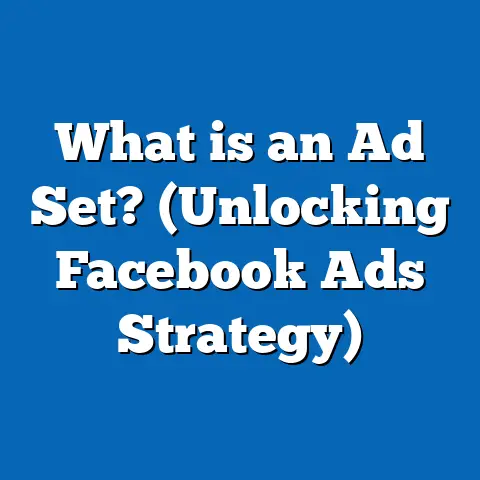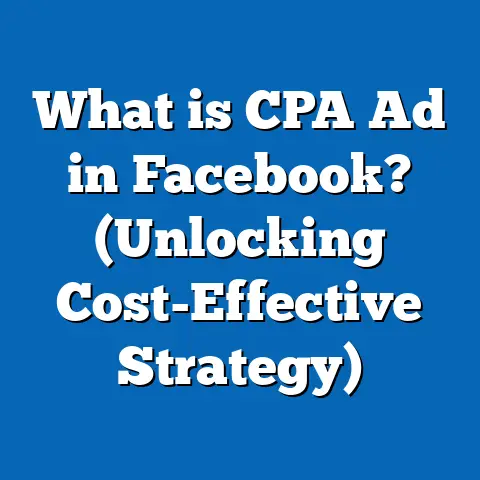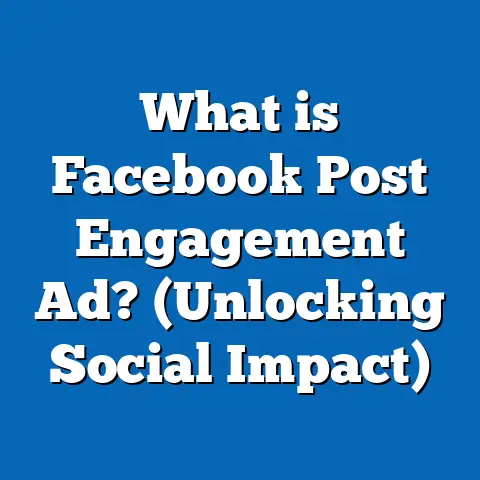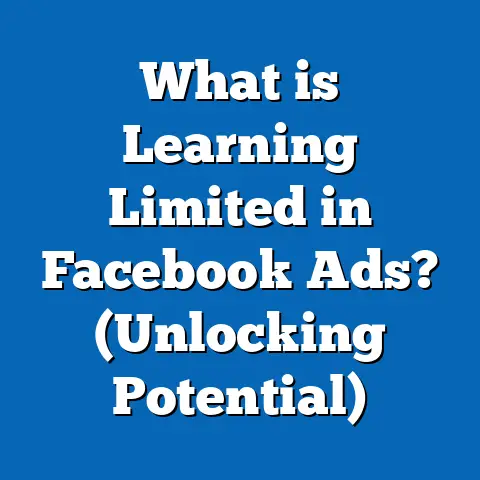What is a Facebook Canvas Ad? (Unlocking Visual Engagement)
What is a Facebook Canvas Ad? (Unlocking Visual Engagement)
Introduction: The Power of Storytelling in Advertising
Imagine scrolling through your Facebook feed. You come across an ad that doesn’t just show a product image or a short video — but instead, invites you on a journey. The screen fills with stunning images, videos play seamlessly, you swipe through galleries, tap on buttons, and explore an interactive experience that feels more like a mini-website than a typical ad. You stay engaged longer than usual, captivated by the story being told, and intrigued enough to click through or make a purchase.
This is the promise of Facebook Canvas Ads, now called Instant Experience Ads — a mobile-first ad format that revolutionizes how brands connect with their audiences on social media. In an era where attention spans are dwindling, and competition for user engagement is fierce, Canvas Ads offer marketers a way to break through the noise using immersive storytelling that blends creativity with technology.
This article will explore everything you need to know about Facebook Canvas Ads: what they are, why they matter, how to create them, real-world success stories, advanced strategies, comparisons with other formats, and future trends shaping this powerful ad tool.
What Exactly is a Facebook Canvas Ad?
Definition and Core Concept
Facebook Canvas Ads are full-screen, interactive ad experiences designed specifically for mobile devices. Unlike traditional Facebook ads that show static images or short videos, Canvas Ads combine multiple types of media — images, videos, text, buttons, carousels, and even tilt-to-pan 360-degree visuals — into one seamless experience.
Key characteristics include:
- Mobile-Optimized: Built for fast loading and smooth interaction on smartphones.
- Full-Screen Immersion: Takes over the entire screen to eliminate distractions.
- Interactive Design: Allows users to swipe, tap, zoom, or scroll through content.
- Hosted on Facebook: Avoids slow loading times by keeping users inside the Facebook app.
This format essentially lets marketers build mini landing pages within Facebook that engage users deeply without sending them away from the platform.
Historical Context: From Canvas to Instant Experience
Introduced in early 2016 as “Canvas,” this ad format was Facebook’s answer to mobile’s growing dominance and the need for richer user experiences beyond simple images or videos. In 2019, Facebook renamed it “Instant Experience” to highlight its speed and seamlessness on mobile devices.
Though the name changed, the core value proposition remains:
Unlocking visual engagement by combining multiple content types into a fast-loading, immersive mobile ad.
Why Facebook Canvas Ads Are Essential in Modern Marketing
The Attention Economy Challenge
We live in an era dominated by short attention spans and information overload. According to Microsoft’s 2023 research:
- The average human attention span has dropped to just 8 seconds.
- Social media users scroll rapidly through feeds; ads have mere seconds to capture interest.
- Approximately 2.7 billion people use Facebook monthly (Meta Q1 2024), making it a vital advertising channel but also highly competitive.
In this environment, traditional static or even video ads struggle to engage users long enough to deliver messages effectively.
How Canvas Ads Address This Problem
Facebook Canvas Ads help marketers by:
- Capturing Attention Longer: Users spend over 30 seconds on average interacting with these ads compared to 3–5 seconds on normal video ads.
- Increasing Click-Through Rates: Data from Facebook indicates CTR improvements up to 30% relative to standard ad formats.
- Reducing Bounce Rates: Since users don’t leave Facebook but explore content inside the app.
- Facilitating Rich Brand Storytelling: Enables layered narratives using mixed media rather than single images or short clips.
Supporting Data and Statistics
| Metric | Standard Facebook Ads | Facebook Canvas Ads (Instant Experience) |
|---|---|---|
| Average Engagement Time | 3–5 seconds | 30+ seconds |
| Click-Through Rate (CTR) | Baseline | Up to +30% |
| Conversion Rate | Baseline | Up to +20% |
| Bounce Rate | High (due to redirects) | Low (content hosted within app) |
These statistics highlight why Facebook Canvas Ads are becoming a go-to for marketers aiming for deeper engagement.
Components of a Facebook Canvas Ad: Detailed Breakdown
To master Canvas Ads, understanding each building block is critical.
Media Types You Can Use
- Images: Use high-quality photos to convey emotion or showcase products. Multiple images can be arranged in grids or carousels.
- Videos: Auto-play videos that explain features or tell stories within seconds.
- Text Blocks: Headlines and descriptions placed strategically for clarity.
- Buttons/Call-to-Actions: Encourage clicks with CTAs like “Shop Now,” “Learn More,” or “Download.”
- Carousels: Swipeable galleries for multiple products or features.
- Tilt-to-Pan 360 Images/Videos: Interactive elements that respond to device motion for a dynamic feel.
- Product Tags: Label products directly within images linking users to purchase pages.
Layout Options and Templates
Facebook offers templates and customization options:
- Full-Screen Visual Story: Single immersive canvas.
- Split-Screen: Two-panel layout combining image/video with text.
- Product Grid/Showcase: Multiple product thumbnails with links.
- Custom Drag-and-Drop Layouts: Using Creative Hub’s intuitive interface.
User Interaction Features
Users can:
- Swipe horizontally through image galleries
- Scroll vertically for long-form content
- Tap buttons for actions
- Zoom into images
- Tilt device for 360-degree views
These interactions keep users actively engaged rather than passively viewing.
How to Create an Effective Facebook Canvas Ad: Step-by-Step Guide
Step 1: Set Clear Objectives
Start by defining what you want your ad to accomplish:
- Product discovery
- Lead generation
- App installs
- Brand awareness
- Event promotion
Your goals will shape your design and content choices.
Step 2: Plan Your Storyboard
Sketch out the flow of your ad experience:
- What’s the key message?
- Which visuals tell your story best?
- Where will CTAs be placed?
Think like a user — what sequence will keep them engaged?
Step 3: Gather Quality Media Assets
High-resolution images and videos are essential. Consider professional photography or video production for the best results.
Step 4: Use Facebook Creative Hub or Ads Manager
Facebook’s Creative Hub allows drag-and-drop creation of Canvas Ads without coding:
- Open Creative Hub → Create New → Instant Experience.
- Upload your assets.
- Arrange components: images, text blocks, buttons.
- Preview on mobile and desktop views.
- Save and export for your ad campaign.
Step 5: Optimize Loading Speed
Compress images (under 1MB), keep videos short (under 15 seconds), and use recommended formats (JPEG for images, MP4 for videos).
Step 6: Launch Campaign & Monitor Performance
Deploy your campaign via Ads Manager. Track metrics like CTR, engagement time, conversions, etc. Use split tests (A/B testing) on different layouts or CTAs.
Advanced Strategies for Maximizing Canvas Ad Impact
Personalization & Dynamic Content
Tailor content blocks dynamically based on user data such as location, interests, or behavior. This makes ads more relevant.
Leverage User-Generated Content (UGC)
Incorporate real customer reviews, photos, or testimonials inside your Canvas Ad. UGC boosts credibility and trust.
Integrate Retargeting Campaigns
Use Canvas Ads as part of retargeting funnels:
- Show immersive product demos to users who visited your site but didn’t buy.
- Re-engage app users with new feature highlights.
Use Strong Visual Hierarchy & Clear CTAs
Guide users visually using bold headlines and contrasting colors. Place CTAs prominently at natural stopping points.
Experiment with Interactive Elements
Try adding tilt-to-pan photos or embedded polls/questions inside your Canvas Ads for higher engagement.
Real-Life Case Studies of Facebook Canvas Ads Success
Case Study 1: Adidas Running Shoes Campaign
Objective: Showcase new running shoe line with immersive storytelling.
Approach: Video demos combined with swipeable product galleries and buy-now buttons.
Results:
- CTR increased by 35%
- Average engagement time rose to 40 seconds
- Sales increased by 18% compared to prior campaigns
This campaign demonstrated how product demos plus easy shopping links boost conversions.
Case Study 2: Airbnb Destination Storytelling
Objective: Inspire travel bookings by highlighting unique destinations.
Approach: Full-screen visuals of locations paired with interactive maps and booking CTAs.
Results:
- Engagement rate grew by 28%
- Bookings attributed to the campaign increased by 22%
The immersive experience helped users explore destinations emotionally before booking.
Case Study 3: Sephora’s Holiday Gift Guide
Objective: Promote holiday gift sets with interactive shopping experience.
Approach: Grid layout showing multiple gift sets with detailed descriptions and direct purchase buttons.
Results:
- CTR improved by 25%
- Average order value increased by 15%
Users appreciated browsing multiple options seamlessly within Facebook before buying.
Comparing Facebook Canvas Ads with Other Advertising Formats
| Feature | Facebook Canvas Ads | Standard Facebook Ads | Instagram Stories Ads | Google Display Ads |
|---|---|---|---|---|
| Full-Screen Mobile Experience | Yes | No | Yes | No |
| Interactivity | High (swipes, taps, zoom) | Limited | Medium | Limited |
| Loading Speed | Instant (hosted internally) | Instant | Instant | Variable (depends on site) |
| Storytelling Potential | High | Low | Medium | Low |
| Engagement Time | Long (30+ seconds average) | Short (3–5 seconds) | Medium | Short |
| Best For | Rich storytelling & conversions | Awareness & reach | Quick brand impact | Retargeting & display reach |
Canvas Ads offer a unique blend of interaction and storytelling not matched by most other formats within social ecosystems.
Technical Aspects Explained Simply
How Does Hosting Inside Facebook Improve Speed?
Canvas Ads are hosted on Facebook servers rather than external websites. This means:
- Faster load times due to optimized delivery networks.
- No redirects — user stays inside the app.
This seamless experience reduces drop-offs caused by slow loading pages.
What Are Tilt-to-Pan Images?
Tilt-to-pan allows users to move their phone physically to “look around” an image or video in 360 degrees. It creates a sense of depth and realism — great for showcasing environments or products.
How Are Clicks Measured?
Every tap on buttons or links inside a Canvas Ad registers as a click event in Facebook reporting. This helps advertisers measure performance accurately.
Practical Examples of Facebook Canvas Ad Use Cases
E-Commerce Product Launches
Showcase new products with detailed videos plus swipeable galleries of different variants/colors. Add direct “Buy Now” CTAs inside the ad.
Travel & Hospitality Promotions
Create immersive travel stories highlighting destinations’ sights, accommodations, and experiences with booking links.
App Install Campaigns
Use interactive demos explaining app features and benefits before prompting users to download directly from the ad.
Event Marketing
Build excitement by showcasing past event highlights in video form combined with registration CTAs.
Common Mistakes to Avoid When Creating Canvas Ads
- Overloading With Content: Too many images/videos can overwhelm users; keep it concise.
- Ignoring Mobile Optimization: Large files slow loading; optimize sizes strictly.
- Weak Call-to-Actions: Clear CTAs guide users toward desired actions.
- Poor Visual Hierarchy: Random layouts confuse users; use consistent design principles.
- Not Testing Variations: Always A/B test different versions for better results.
Future Outlook: Innovations Shaping Facebook Canvas Ads
AI-Powered Creative Suggestions
Facebook is integrating AI tools that recommend optimal layouts, color schemes, and content sequencing based on campaign goals and audience data.
Augmented Reality (AR) Integration
AR features embedded within Canvas Ads will allow users to virtually try products like makeup or furniture directly inside ads without leaving Facebook.
Enhanced Personalization Through Machine Learning
More dynamic content blocks tailored automatically at scale based on real-time user behavior will drive even higher relevance and engagement.
How Businesses Can Start Using Facebook Canvas Ads Today
Step 1: Audit Your Current Mobile Traffic & Engagement Metrics
Understand how your existing ads perform on mobile before moving into immersive formats.
Step 2: Invest in Quality Visual Content Production
Hire photographers/videographers experienced in mobile-friendly creative assets.
Step 3: Train Your Marketing Team on Facebook Creative Hub Toolset
Ensure your team knows how to build and preview Instant Experience ads effectively.
Step 4: Launch Pilot Campaigns & Measure Impact Closely
Start small with clear KPIs like CTR uplift or conversion increases before scaling budgets.
Step 5: Iterate Based on Data & User Feedback
Refine layout/design/CTAs continuously using real-world data insights.
Conclusion: Unlocking Visual Engagement with Facebook Canvas Ads
Facebook Canvas/Instant Experience Ads represent a leap forward in social media advertising. By combining immersive storytelling with fast-loading interactivity tailored for mobile devices, these ads help brands stand out in crowded feeds while driving meaningful engagement and conversions.
For marketing professionals and business owners looking to stay competitive in digital advertising:
- Master the art of visual storytelling within your ads.
- Use data-driven insights to optimize every element of your campaign.
- Experiment with personalization and interactive features.
- Keep an eye on emerging trends like AR integration.
By doing so, you can unlock the full potential of Facebook Canvas Ads — turning casual scrollers into engaged customers through compelling visual journeys that captivate and convert.





